The participation of neo-Nazi groups in the Ukrainian government’s antiterrorist operation discredits the peace effort.
On May 2, Europe saw its first major terrorist attack in years. The incident occurred in the bucolic southern Ukrainian resort city of Odessa, famous for its Greek and Jewish heritage, as well as a strong artistic tradition. The usual suspects were not involved; neither al-Qaeda, nor the Taliban, the Islamic State or even some offspring of the Red Brigades carried it out.
The perpetrators were from a neo-fascist group with special privileges under Kiev’s new Ukrainian government, born of the Western-backed February Maidan revolution. The leader of the ultra-nationalist Right Sector, Dmitro Yarosh, had been offered — but turned down — the deputy chairmanship of the country’s powerful Security and Defense Council after the overthrow of President Viktor Yanukovich. Right Sector’s website was effusive about the Odessa atrocity: “May 2, 2014, is another bright page in our national history.”
In the same announcement, it also claimed responsibility for what was essentially a terrorist attack: “[A]bout a hundred members of ‘Right Sector’ and patriotic-minded Odessa residents countered the rebels,” and “Dmitro Yarosh ignored the ‘expedience’ of the election campaign to coordinate the action against the Russian aggression.” The campaign to which the Right Sector refers was for the presidential election to be held 23 days after the pogrom/terrorist attack. In between his “coordination” activities, Yarosh openly campaigned and ran for the presidency — winning 1% of the vote. However, Yarosh and Right Sector’s game is politics by distinctly other means.
Right Sector’s Odessa pogrom is far from being an isolated incident. It is just one of many crimes committed by forces closely tied to the new regime in Kiev, and Right Sector is but one of the many extremist forces being forged in the crucible of revolution and civil war spawned on the Maidan. As October approaches, violence continues in the east and the ominous specter of socioeconomic breakdown persists. The strain is creating fissures within the Maidan coalition between centrist-democrats — radical nationalist elements are growing. The conflict between the government in Kiev and the remnants of the revolutionary forces on Maidan is being driven by both ideological and strategic-tactical differences. The latter rage over how to defeat the Donbass rebel resistance.
There are several Ukrainian ultra-nationalist forces, in addition to Yarosh and Right Sector, that are poised to take advantage of the divisions and chaos, and bid for power — including Oleg Tyahnybok’s so-called Freedom Party, and Oleg Lyashko’s Radical Party. In order to understand fully the nationalist element in the new regime in Kiev, we need to go back to Maidan and the heady days of the “pro-democracy” revolution and overthrow of Yanukovich.
Maidan and the Ultra-Nationalists
In autumn 2013, as Western governments and media enthused over the rise of yet another democratic revolution in Kiev, the demonstrators gathering on the famous Maidan — or central square — were from an ideologically, politically or socially diverse group. A key element consisted of nationalist, ultra-nationalist and neo-fascist groups. By late November, the Maidan was forming self-defense forces: the “holy hundreds” or sotniki. Unsurprisingly, the bulk of volunteers for the sotniki came from nationalist and neo-fascist groups. One Andriy Parubiy, who had a history of ultra-nationalist activity, was put in charge of Maidan’s self-defense forces. In 1991, Parubiy co-founded, along with Tyahnybok, the radical nationalist Social-National Party of Ukraine, which included Nazi insignia and anti-Semitic pronouncements and evolved into Tyahnybok’s Freedom Party.
On May 2, Europe saw its first major terrorist attack in years. The incident occurred in the bucolic southern Ukrainian resort city of Odessa, famous for its Greek and Jewish heritage, as well as a strong artistic tradition. The usual suspects were not involved; neither al-Qaeda, nor the Taliban, the Islamic State or even some offspring of the Red Brigades carried it out.
The formation of Right Sector was part of this quasi-militarization of the Maidan. On November 26-27, four ultra-right groups joined forces to found Right Sector: Stepan Bandera’s Trident, named after the head of the Ukrainian nationalist leader who allied and carried out massacres of Poles and Jews in league with the Nazis during World War II; the Ukrainian National Assembly; White Hammer; and the ultra-fascist Social National Assembly (SNA). The SNA’s program gives a glimpse of its ideology: “nationocracy.” It proposes banning all political parties, organizations, associations and ideological groups. The elite of the Ukrainian ethnic group or nation will hold full power: “Political power is wholly owned by the Ukrainian nation through its most talented, idealistic and altruistic national representatives who are able to ensure proper development of the nation and its competitiveness.”
“Supreme power (executive, legislative and judicial) of the Ukrainian state will be in the hands of the head of state, who is personally responsible to the nation’s own blood and property.” Capitalism is to be “dismantled” and democracy is to be “eliminated.” All actions that fail “to comply with obligations to the nation and the state will entail the restriction of civil rights or deprivation of citizenship … The ultimate goal of Ukrainian foreign policy is world domination.” Having gotten word of this radicalization and quasi-militarization, Yanukovich’s Berkut special police forces paid informal titushki thugs to beat up demonstrators on the night of November 30. The result was the radicalization and militarization of Maidan, and a vindication for the creation of the sotniki and Right Sector.
Revolutionary Seizure of Power
Through the cold winter months, the sotniki and Right Sector acted as the revolution’s shock troops that not only defended Maidan, but by January were increasingly on the offensive: attacking police with metal bars, baseball bats and Molotov cocktails, as well as occupying most government buildings in central Kiev. As the crisis deepened, the German and French foreign ministers as well as the Russian envoy, Vladimir Lukin, began brokering an agreement to put an end to the crisis and negotiate Yanukovich’s extrication from power. At the same time, a series of mysterious sniper attacks unfolded during the negotiations on February 18-20, killing some 40 people. The attacks, which were initially blamed on Yanukovich’s Berkut, served to aggravate tempers on the Maidan, tipping the scales in favor of the ultimate revolutionary outcome.
However, that version of events quickly fell apart, as many eyewitnesses confirmed that snipers targeted both police and revolutionaries, and doctors reported that casualties occurred on both sides. On March 5, an audiotape, likely recorded by Russian or perhaps Ukrainian intelligence, emerged on the Internet with Estonian Foreign Minister Urmas Paet and European Union Foreign Policy Chief Catherine Ashton discussing the sniper attacks. Both verified the veracity of the call and its contents. On the tape, Paet says that the people on the Maidan and elsewhere were increasingly convinced that snipers were provocateurs and likely came from within the revolutionary camp. He also reported that the pro-Maidan physician Olga Bogomolets had examined the corpses of demonstrators and police: Both had been shot by the same bullets.
Since then, the results of several journalistic investigations cast a grave shadow of doubt on Kiev’s version claiming that pro-Yanukovich forces were behind the sniper attacks and point a finger at the Maidan. The new Ukrainian government’s own investigation announced preliminary findings on May13,which conclude that the snipers’ bullets were not the kind used by Berkut. German and other foreign journalists analyzed video that shows snipers fired from atop the Hotel Ukraine, which was under the control of Maidan’s sotniki. If pro-revolutionary forces were behind the sniper attacks, then it will most likely turn out to have been the word of the “ultras.” Democrats do not usually deploy snipers to make revolutions.
On February 21, Yanukovich came to an agreement with the opposition that would lead to his stepping down from power by the end of the year. The agreement also stipulated that Yanukovich issue a decree within 48 hours, returning the country to the 2004 constitution and weakening his executive powers; the holding of a presidential election, which virtually guaranteed his removal from office; and pull all police and Berkut forces from the city center. In return, the opposition was to abandon all squares and buildings in central Kiev.
The ultra-nationalists’ leading role in fighting the police on the Maidan and forcing Yanukovich from power translated into key appointments in the post-revolutionary government.
But the Maidan’s sotniki violated the February 21 agreement within hours. Rather than withdrawing from buildings and squares in Kiev, they occupied more buildings and threatened to take the presidential administration and kill Yanukovich. When Yanukovich fled Kiev for Kharkiv, the radicals stormed the parliament and oversaw the president’s illegal impeachment in violation of the constitutional procedure for such. They helped prevent the required quorum and kept down the pro-Yanukovich vote in the impeachment by detaining and sometimes beating deputies from his Party of the Regions. In other words, the ultra-nationalists and neo-fascists spearheaded the revolutionary seizure of power using significant force.
Under the Maidan Regime
The ultra-nationalists’ leading role in fighting the police on the Maidan and forcing Yanukovich from power translated into key appointments in the post-revolutionary government. Tyahnybok’s Freedom Party members were appointed to head five ministries in the provisional government: Deputy Prime Minister Oleksandr Sych; Ecology and Natural Resources Minister Andrey Mokhnyk; Agriculture Minister Ihor Shvayka; Prosecutor General Oleh Makhitskiy; and Defense Minister Ihor Tenyukh.
In addition, the de facto purge by intimidation of many Party of Regions deputies from the Rada gave the Freedom Party greater weight in parliament than its 10% of the seats would otherwise provide. Freedom Party members proudly posted a video of themselves beating the director of Ukrainian state television for broadcasting the Kremlin ceremony officially annexing Crimea by Russia. More importantly, for his organizational efforts on the Maidan, radical nationalist Parubiy was given the key post of chairman of Ukraine’s Security and National Defense Council. He would focus much of his activity on recruiting his “hundreds” and Right Sector-like groups into the Ukrainian army and National Guard prior and during the “antiterrorist” operation in the east.
Here the ultra-nationalists are again playing the lead role in Kiev’s antiterrorist operation to crush eastern Ukraine’s separatist rebels. This could allow the nationalists to increase their political weight once the rebels are crushed, and the leaders and the volunteer battalions they control return home. Tyahnybok and the Freedom Party have been suspiciously quiet, continuing to lead the nationalist cause in parliament and government ministries. The declining authority of the Maidan-installed government is allowing competitors within the ultra-nationalist movement to overtake them.
The rising dark horse within the movement is the youthful Lyashko and his Radical Party. Lyashko, a deputy in Ukraine’s parliament, or Rada, champions “the sacred cause — creation of a Great Kievan Empire.” His party is polling strongly, with parliamentary elections and intensifying social dislocation set for autumn. In a June-July survey conducted by the Kiev International Institute of Sociology (KIIS), the Radical Party registered as Ukraine’s most popular party among likely voters, supported by 12.5% of respondents.
The moderately national chauvinist and de facto ruling party, Batkyvshchina, took 9.3%; centrist Vitaliy Klitchko’s Udar Party received 7.2%; Tyahnybok’s Freedom Party had 3.7%; and Yarosh’s Right Sector with 1%. Undecided voters comprised 46%. Therefore, according to KIIS, if the elections were held and all undecided voters stayed at home, as of July the Radical Party would win nearly a quarter (23.1%) of the Rada’s seats, the Freedom Party with 5.7%, and Right Sector with 1.9%. This would give the neo-fascist movement 30.7%, with some deputies from other factions also sympathetic to their cause. And this is the case before the expectedly hot autumn has ensued.
Lyashko and his Radical Party and Yarosh and his Right Sector have committed several of what can be characterized as terrorist attacks in recent months. In addition, their recruits into the Ukrainian army and National Guard are likely behind some of the raping, pillaging and shelling of residential areas in the war. As this author noted months ago, Lyashko claimed responsibility for organizing the storming of a government building in Torez by his “soldiers from the Lyashko Battalion ‘Ukraine’” on May 23. Lyashko’s soldiers killed an unarmed pro-Russian supporter of the breakaway Donetsk People’s Republic and maimed a second.
Other battalions with neo-fascist elements, like the oligarch and Dneprpetrovsk Governor Ihor Kolomoiskii’s signature Dnepr Battalion, are also making illegal arrests that include beatings and likely torture.
Immediately after the murder, Lyashkov boasted on his Facebook page: “Soldiers from Battalion ‘Lyashko Ukraine’ just liquidated and released from the Colorado the executive committee of Torez, Donetsk Oblast. Two terrorists killed, nobody among our soldiers suffered there. Glory to Ukraine!” The post received 5,000 likes in just a few hours before Lyashko deleted it. But the Kyiv Post retrieved a cached mobile version.
Despite this record, Lyashko attended a high profile July 1 meeting with Petro Poroshenko, in which he announced his plan for the second phase of the antiterrorist operation in Donbass. After hearing from the president “what he had wanted to hear from him,” Lyashko returned to his nationalist vigilantism.
Soon, Lyashko’s activities earned him a rebuke from Amnesty International, which calls them “a terrible violation of international law and standards.” Amnesty has asked Ukraine’s prosecutor general to investigate Lyashko for organizing abductions, noting:
“Though he doesn’t have the right to detain people, he abducts them and abuses them verbally and physically while the camera is rolling. His and other similar websites feature numerous video clips showing what appear to be cases of abduction and violations of the rights to fair trial, liberty and security of the person, and the right not to be subjected to torture and other ill-treatment.”
Lyashko boasts of his work:
“If the government and law enforcers are inactive, the patriots must act. Especially now, when Ukraine is fighting for its independence.” His Radical Party members are also prominent in the Shakhtyorsk Battalion ostensibly subordinated to the Internal Affairs Ministry headed by the nationalist Arseniy Avakov. Lyashko is demanding that Radical Party members fighting in the anti-terrorist battalions “have to immediately after the war become prosecutors, judges etc.”
Much of the criminal activity being carried out under the cover of the antiterrorist operation is rooted in the recruitment of volunteers from and through Lyashko’s and Yarosh’s organizations. Lyashko was removed allegedly as a supplier of his fighters after Avakov discovered that 12 of the first 15 Lyashko recruits had criminal issues.
Other battalions with neo-fascist elements, like the oligarch and Dneprpetrovsk Governor Ihor Kolomoiskii’s signature Dnepr Battalion, are also making illegal arrests that include beatings and likely torture — adding to the general disintegration in law and order and reflecting Ukraine’s state breakdown, democratic backsliding and violations of human rights. These acts are often videotaped and posted on the Internet.
As noted above, Yarosh and Right Sector led and promptly claimed responsibility for the horrendous May 2 terrorist attack in Odessa. Moreover in April and May, while Kiev refused to negotiate with the rebels, regular Ukrainian army troops along with Right Sector and Right Sector-penetrated National Guard troops attacked southeastern resistance forces, who had undertaken no operations, and unarmed activists. For example, in late April, they killed some 30 of the Donetsk resistance in and around Slavyansk and, in Mariupol, they killed another 20 for refusing to crack down on demonstrators. Some of the Mariupol casualties were unarmed civilians. One was a Russian journalist.
Yet months after the Odessa atrocities, Yarosh remained free and was allowed to travel from his field headquarters in Dnepropetrovsk to Kiev and participate in a presidential debate. Yarosh ran in the May 25 presidential election, unhindered by Kiev’s law enforcement organs controlled by leaders with ties to Tyahnybok. Ukrainian state and independent media have given Yarosh and the Right Sector a free pass. Even Poroshenko has refused to speak out against Yarosh, least of all called for the arrest of him and his storm troopers. Poroshenko most likely has no sympathy for the neo-fascists’ ideology. His lack of action against them seems to be motivated by a fear that it could split the Maidan coalition and spark a neo-fascist backlash, even a coup. At present, Yarosh and many of his Right Sector members are fighting openly under the banners of oligarch Igor Kolomoiskii’s numerous battalions nominally subordinated to the Defense or Internal Affairs Ministry and National Guard — such as the Donbass, Dnepr and Azov Battalions in Poroshenko’s Western-backed antiterrorist operation.
Western claims that the ultra-nationalist element is non-existent or at least irrelevant are dangerously off the mark. Ignoring reality, the West’s unqualified support for Kiev’s politics, its antiterrorist operation and its refusal to negotiate with Vladimir Putin over the crisis will come home to roost.
The aforementioned ultra-fascist SNA predominates in the several hundred-strong Azov Battalion. The SNA’s leader, Andriy Beletskiy, is Azov’s commander and has written: “The historic mission of our nation in this critical moment is to lead the White Races of the world in a final crusade for their survival … A crusade against the Semite-led Untermenschen.” According to the one journalist who has examined this subject in any detail, the Azov Battallion’s ideology is Nazi-oriented — as are many of its members — who include not just ethnic Ukrainians and Russians from Ukraine, but also volunteers and mercenaries from Greece, Ireland, Italy and Scandinavia. Azov’s fighters are emblazoned with Nazi insignia, espouse Nazi ideas, and fly a neo-Nazi flag.
The Donbass, Dnepr and Azov battalions along with regular army artillery units are responsible for many of the attacks on civilians and residential areas in eastern Ukraine under Avakov’s antiterrorist operation. The tactics appear to be that regular army artillery units soften the target, “followed by chaotic, violent assaults” by the battalions. The Ukrainian army and some of the more well-armed neo-fascist battalions’ paramilitary groups have been using heavy weapons, including unguided Grad rockets, in civilian-populated areas for months. Human Rights Watch released a belated report condemning Kiev’s practice.
The Ministry of Internal Affairs (MVD) chief, Avakov, Parubiy, and other officials defend their use of neo-Nazis in their antiterrorist operation. According to Avakov’s advisor, Anton Gerashchenko: “The most important thing is their spirit and their desire to make Ukraine free and independent. A person who takes a weapon in his hands and goes to defend his motherland is a hero. And his political views are his own affair.”
The Ultra Coup Threat
The political views of Ukraine’s ultra-nationalist battalions could have far broader resonance in the present period of political violence, economic collapse and social chaos. There is a real risk that neo-fascist warlords like Beletskiy and Yarosh will attempt to seize power in a coup during or after the antiterrorist operations, in the event that key decisions do not go their way and/or Ukraine’s domestic circumstances continue to deteriorate.
Indeed, the powerful Donbass Battalion and its commander, Semyon Semenchenko, recently demonstrated this potential. On the eve of President Poroshenko’s pivotal June 30 meeting with Parubiy, Avakov and the powerful Defense and Security Council, Semenchenko and members of his battalion led a several thousand-strong demonstration backed by two other “volunteer” — Dnepr and Aidar — battalions. The demonstrators demanded that Poroshenko end the truce, declare martial law and destroy the eastern rebels, or they would remove the president from power “like Yanukovich.”
At the demonstration, a journalist was beaten up and stun grenades were thrown, seriously injuring several demonstrators. One demonstrator claimed he saw MVD officers hand the stun grenades to members of Avakov’s Kiev-based paramilitary group 17+ Sotny, who threw the grenades. Although Avakov condemned the violence the next day, no one was arrested.
Before the June 30 council meeting, Poroshenko had said he intended to extend the truce after its June 30 deadline, in accordance with the wishes of Brussels and Moscow. However, after the four-hour long meeting, he emerged to announce an end to the truce and ordered a new offensive to wipe out rebels. The Donbass Battalion and its ilk had prevailed over the great powers of Europe and Russia.
The June-July scenario played out once more on August 6, when the authorities in Kiev sought to clean Maidan of remaining demonstrators. Right Sector, which constantly criticizes the government and calls for a purge of the Ukrainian elite, attacked the Kiev’s efforts and called for the resignation of Avakov. Right Sector has organized small demonstrations and pickets in the nationalists’ stronghold in western Ukraine. In August, Right Sector activists stormed a concert of an allegedly pro-Russian singer, Anna Lorak, an action that had to be put down by police. In response, the Right Sector again called for demonstrations and Avakov’s resignation.
On August 7, Parubiy resigned as chief of the Security Council, reportedly so that he could focus on his work supporting the volunteer militias. The reason for his resignation may be that Parubiy understands the Maidan government — in its present configuration — will collapse, and he is preparing for a return to power on the back of his battalions’ volunteer fighters returning home from war — either emboldened by victory or disgruntled by stalemate or defeat. Such a situation could be ripe for a coup or electoral path to power on an ultra-nationalist agenda.
Negotiate With the Rebels
None of the above should be construed as a claim that all the forces in the post-Maidan government are neo-fascist, as some Russian statements state or imply. Rather, it should serve as a warning to the West that the threat of a fascist hijacking of the Maidan regime is growing, and Western claims that the ultra-nationalist element is non-existent or at least irrelevant are dangerously off the mark. Ignoring reality, the West’s unqualified support for Kiev’s politics, its antiterrorist operation and its refusal to negotiate with Vladimir Putin over the crisis will come home to roost.
The West, especially the US, is operating under and proselytizing the illusion that Maidan was purely a democratic revolution, aimed at overthrowing a corrupt regime installed by devilish Putin’s Russia. We have been shown this scenario before — with the West’s misplaced support in Georgia for the beacon of democracy, former President Mikheil Saakashvili, who started the August 2008 war with South Ossetiya and has been indicted in absentia for illegally nationalizing the media, cracking down on demonstrators and torturing prisoners during his rule.
The West must take off its black and white blinders. Putin and the Russians are not the only kleptocratic autocrats and opportunistic nationalists in the post-Soviet space, which includes almost nothing but such elements. The good news is that real fascists of Lyashko’s, Beletskiy’s and Yarosh’s ilk are not in power yet. The West can avoid this by demanding that Kiev clean up its act and limit the chaos of war by forcing Poroshenko to negotiate with the rebels.
The views expressed in this article are the author’s own and do not necessarily reflect Fair Observer’s editorial policy.
6 comments
Leave a comment
You must be logged in to post a comment.
Support Fair Observer
We rely on your support for our independence, diversity and quality.
For more than 10 years, Fair Observer has been free, fair and independent. No billionaire owns us, no advertisers control us. We are a reader-supported nonprofit. Unlike many other publications, we keep our content free for readers regardless of where they live or whether they can afford to pay. We have no paywalls and no ads.
In the post-truth era of fake news, echo chambers and filter bubbles, we publish a plurality of perspectives from around the world. Anyone can publish with us, but everyone goes through a rigorous editorial process. So, you get fact-checked, well-reasoned content instead of noise.
We publish 2,500+ voices from 90+ countries. We also conduct education and training programs
on subjects ranging from digital media and journalism to writing and critical thinking. This
doesn’t come cheap. Servers, editors, trainers and web developers cost
money.
Please consider supporting us on a regular basis as a recurring donor or a
sustaining member.
Will you support FO’s journalism?
We rely on your support for our independence, diversity and quality.




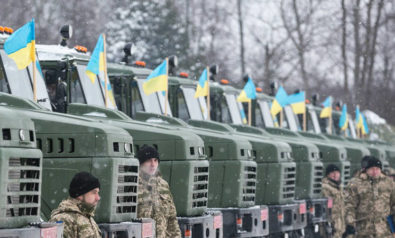

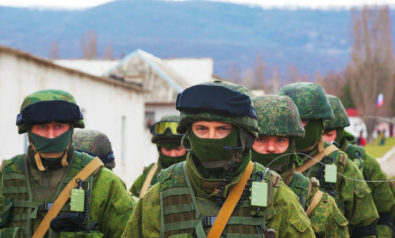
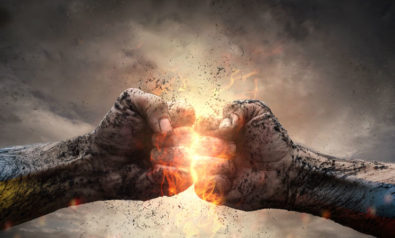
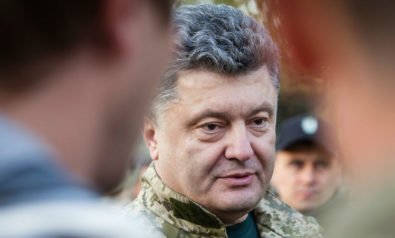
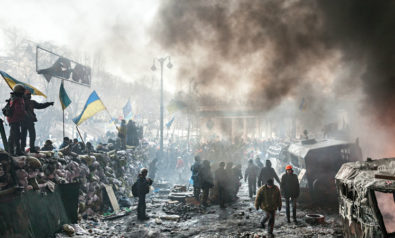

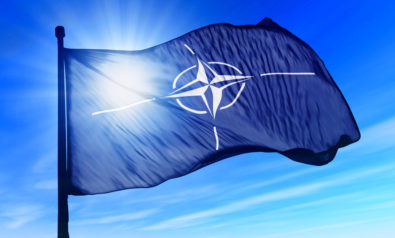

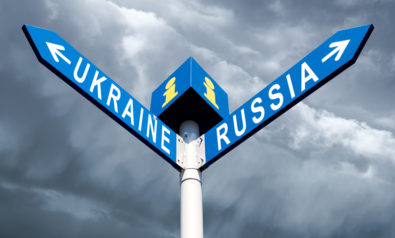
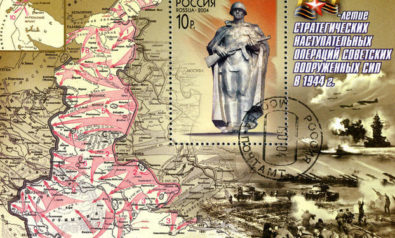
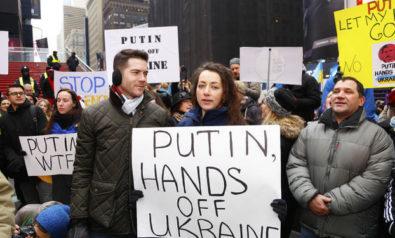

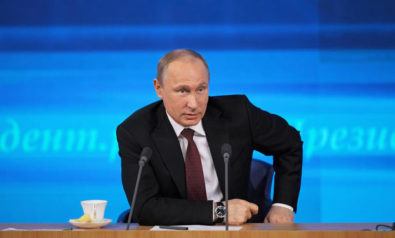
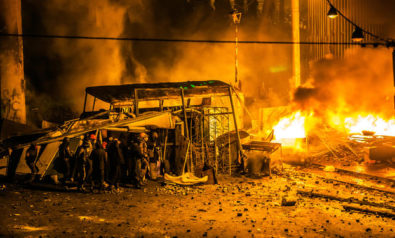

AP
September 27, 2014
While the author's facts are mostly correct, they are used to present a picture that is not completely accurate. The author is correct to condemn the ugly neo-fascist element within the post-revolutionary Ukrainian government and forces (although he fails to acknowledge that the opposing side is even more compromised with neo-Nazi elements - Pavel Gubarev, the "People's Governor" of Donetsk, is himself a former leader of the swastika-sporting neo-Nazi Russian National Unity organization and has more stature within the rebel movement than any of the neo-Nazis has within the pro-Kiev forces). Without at least briefly mentioning this context, an unwitting reader would get the false impression that from the perspective of neo-fascists this is a one-sided conflict, pro-Kiev fascists vs. clean resistance. He correctly notes that far-right fighters spearheaded the violent street fights that led to Yanukovich's fall. These young hotheads were most likely to brave police batons and bullets, although they were not the only ones battling police. However, he does not mention that nationwide polls showed a plurality of support for the revolution (40.1%, in comparison to only 23.3% supporting the Yanukovich government - with 31.9% supporting neither side). He also does not mention that the parties that came to power as a result of the revolution were exactly the same ones who had won the popular vote in the previous two parliamentary elections, but were denied control of parliament due to "reforms" created by and for Yanukovich and his party. The leaders of these parties were each polling well ahead of Yanukovoch also. Fear of Yanukovich subverting the next presidential elections as he had the parliamentary ones was a driving force behind this revolution; indeed his parliament had already passed a law preventing the frontrunner at the time from running. When asked why people were protesting, the top reason given by people form western and central Ukraine, the pro-protest regions, was to oust Yanukovich's corrupt government. The author correctly notes that the radical rightwing Svoboda Party received 5 ministerial posts. But he didn't mention that at the time of this article's publication this was down to three posts (out of 20) - a number lower than Svoboda'a percentage of the parliament and that Svoboda's popularity was declining. The author provides poll data from June giving the Radical Party 23.1% of the vote. However another poll September 3rd by the same polling agency shows rather different results (perhaps the author wrote this prior to the new results being made available). In that poll, 28.5% of decided voters would choose Poroshenko's Party, 16.5% Lyashko's Radical Party, 10% would vote for Batkivshchnya, 9.2% Civil Position (a moderate but pro-NATO party led by a former defense minister), 7.2% UDAR (allied to Poroshenko), and 6.9% Svoboda. 4.7% would vote for Tyhypko's Strong Ukraine, 3.9% for the Communists, 2.2% for Party of Regions, and 1.8% for Right Sector. The latter parties would not clear the 5% hurdle to get into Parliament. Excluding those parties, the Far Right would have 23.4% of the Parliamentary vote and would be quite easily outnumbered by the moderates. So there would be a moderate President, a moderate Parliament, and a far right opposition. For comparative purposes, the far right in Ukraine would be about as popular as Zhirnovsky had been in Russia in the early 1990s, and less popular than the National Front in the latest European parliamentary elections in France.
AP
September 29, 2014
Update: A new poll came out about parliamentary elections. Poroshenko and Klitschko's UDAR are now in one group. We see that Lyashko continues to slip downward: http://www.kiis.com.ua/?lang=eng&cat=reports&id=400&page=1&t=3 Of those planning to vote and who know whom they will vote for: 39.5% for Poroshenko's Party 10.4% Lyashko 7.8% Fatherland (Tymoshenko) 6.9% Civic Platform (moderate pro-NATO, led by former defense minister) 5.8% National Front (Yatseniuk) 5.2% Strong Ukraine (Tyhypko) - the sole "pro-Russian" party that will clear the 5% hurdle to make it into parliament These parties poll below 5% and thus wouldn't make it into parliament: Svoboda (4.7%) Communists (4.5%) UDAR (even though it's not officially running - confused fans?) 4.3% So it looks as if it will be a moderate west-oriented parliament dominated by Poroshenko's Party, with a relatively weak far right opposition and a marginal pro-Russian "second" opposition. An important note: 40% of Kharkiv voters would refuse to take part and another 5% would vote but would cross out all the parties. One can safely say that these are disenfranchised pro-Russian voters. (the percentage of people voting for pro-Western parties in Kharkiv is projected at 27% - actually a modest improvement over their typical low-20s% performance there). In southern Ukraine (Dniprotetrovsk, Odessa) these figures are only 24% and 2%, respectively. Given the strong lead of pro-Western parties in this region, it seems clear that even when taking into account those who will refuse to vote, this part of the once-Blue Ukraine has flipped.
Boris
October 8, 2014
1. USA and Europe support Ukrainian Neo-Fascists. Should had stay away from that garbage. 2. While I agree that a number of Russian ultra-nationalists is fighting on a rebel side, it's only Ukrainian nazis who openly wear fascist marks and carry flags with fascists symbols. They also talking about pure white race etc. 3. Comparison of active ukrainian fascists with Pavel Gubarev, the “People’s Governor” of Donetsk, is completely unfair. Ones upon a time, at the age of 19, he indeed joined a russian ultra-nationalist group "Russian National Unity" and received a military training. He left them soon after and returned to Donbass, where he was a member of the Progressive Socialist Party of Ukraine. 4. Neo-fascist parties "Right Sector" and "Svoboda" indeed don't have a popular support among ukraine's population, but they grabbed 5 out of 20 cabinet seats after they seized the power. This is why what happened in Kiev was a coup, and their government is a junta.
Catherine Fitzpatrick
February 22, 2015
Polling data is interesting but it doesn't matter because the real test of the influence and power of these far-right groups is whether they are elected. And they weren't. None of the ultranationalist parties like Right Sector and Svaboda cleared the 5% threshold to get in the parliament. A grand total of 8 seats out of 450 have been taken by Right Sector or Svaboda through single-mandate elections in districts. There is no evidence that they can sway the parliament. The naming of a right-winger to the chief of police job isn't something that anyone has been able to show has led to abuses or allowing cronies to escape prosecution. Happy to hear the cases when they are actually available. As for the Odessa fire, this is outrageously and tendentiously portrayed, forgetting the basic facts visible to all on numerous videos: 1. The Russian-backed separatists fired at and killed Ukrainian demonstrators FIRST. 2. Those Ukrainian nationalists chased the separatists to the Trade Union building. 3. The Russian separatists had already planned to occupy and hold the building and brought supplies, first aid kits and fuel into the building. 4. Some of their leaders had already moved to a new location, knowing they would be attacked. 5. Both sides threw Molotov cocktails which started fires. 6. The separatists fired guns from the top of the building, killing some below. 7. The separatists barricaded themselves into the building by piling up office furniture which the 8. For a long period as is visible in multiple videos, anyone in the building could have left. They chose not to because they wanted to occupy and hold it. 9. Nationalists helped separatists out of the building and assisted them once they were out; the occurrences of some beatings by nationalists can't offset the actual footage seen and testimony of neutral or separatist witnesses that indeed nationalists did help. 10. Those who died tended to be teenagers or elderly who didn't leave and moved up stairs, which led to their deaths by the gases formed by such conflagrations as well as flames. To call this a "pogrom" when Russian separatists STARTED this round of violence by shooting DEAD demonstrators, then BARRICADED THEMSELVES into a building is really to STRETCH the meaning of the word "pogrom". It is a tragedy. Both sides used violence. The fault for this starts first with Putin, then goes on down to the separatists who used violence to take over buildings all over the southeast, hundreds of them. When the Right Sector people speak of how they repelled the separatists, they mean they did not let them take over YET ANOTHER town as they already had. As for Mariupol, this is another tendentious story that lots of video analysis done by me and Bellingcat illustrates is false. Separatists tried to take over the police station as they had in other towns. They were repelled which is the right of Ukrainian forces when dealing with Russian-backed militants trying to occupy their towns. Ukrainians were rightly defending their territory, and if people were killed in this incident it's a tragedy, but then, separatists shouldn't have been taking buildings over by force to solve their "language" issues *cough*. In the second incident by the cafe, it's clear that provocateurs popped up in the crowd and shot bullets and slingshots at police, who fired back on the ground -- some ricochet bullets killed pedestrians. #RussiainvadedUkraine.
Catherine Fitzpatrick
February 22, 2015
*which then prevented their escape.
Tim Declercq
March 3, 2015
The one who is outrageously and tendentiously displaying the Odessa massacre is you. As anyone can see on the video evidence. 1. Before any clashes even started Ukrainian nationalists can be seen saying to the head of police "If you don't clean up the separatists we will". 2. There is no evidence that those doing the shooting in the beginning were separatists, in fact the evidence suggests they were provocateurs, as can be seen by them discussing and mingling with both police and Ukrainian nationalists. 3. The nationalists didn't follow anyone to Kulikovo. The shooters disappeared behind police lines, and at least one is seen leaving together with the head of police surrounded by friendly Ukrainian nationalists. 4. Most of the people present at Kulikovo were peaceful protesters who were in no way involved in the earlier clashes. 5. As the nationalists were approaching Kulikovo (not following anyone) they can be heard calling for "burning them". This clearly establishes intent. 6. Both sides threw molotov cocktails but as can be clearly seen several fires were started by the nationalists throwing them, compare this with the point above. 7. The nationalists can be seen entering the building through a side-entrance under calls for "killing the Russians and communists". Inside they can be seen forcing entry into rooms and dragging away at least one woman who is pleading for them not to do this. 8. People can be heard screaming inside for their lives, in sections that weren't on fire, where after the voice was silenced Ukrainian nationalists can be seen waving the Ukrainian flag from the windows. All this under calls of "Glory to Ukraine! Death to the enemies!" from some in the crowd outside. 9. Nationalists can be seen blockading firetrucks from reaching the scene. 10. While it is true that many people in the crowd started helping those caught inside, in other sections of the building a clear massacre was taking. So to sum up, there was a clear hardline core of Ukrainian nationalists who with established intent were indeed carrying out a massacre and using the actions of provocateurs as an excuse to do it. That many in the crowd tried to help the people inside in no way changes that. Look up "Roses have thorns (Part 6) The Odessa massacre" on youtube for the video evidence of this.